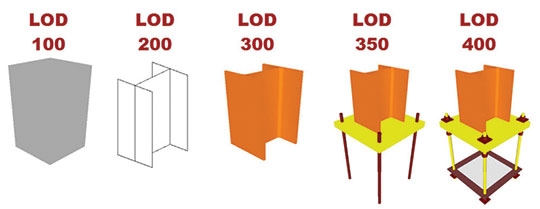Everyone with an interest in BIM has struggled with LOD. Not just with the term’s subtleties of meaning and inconsistent use: “Does LOD here mean ‘Levels of Definition’ or ‘Level of Development’ or ‘Level of Detail’, and how does it differ from ‘Level of Information’?” But also with the practical application of this labor-intensive and often inefficient approach to managing BIM data.
The approach is, after all, mandated by the world’s many BIM standards (big complex documents which are nevertheless often incomplete and ambiguous for practitioners). It’s standard protocol. And it’s leading to information overload, confusion and workflow breakdowns.
 BIM, since the notion emerged, was always about innovation for efficiency in the gathering, exchange and use of data in the AEC industries. What it’s become, however, is the unthinking accumulation of more and more data just to tick all the boxes in a policy document.
BIM, since the notion emerged, was always about innovation for efficiency in the gathering, exchange and use of data in the AEC industries. What it’s become, however, is the unthinking accumulation of more and more data just to tick all the boxes in a policy document.
Take an example where we’ve decided to use LOD 200. I’ll do the geometry specified in the standards. But the gurus who wrote the standards say “non-graphic information may also be attached.” So along with the geometry, I’ll put some information that’s important to me to the model, and my project partners will add information of their own. Later, at other LODs, others will add more information. And it’s never clear who should be responsible for what.
 It’s a routine – the opposite of innovation. And it’s inefficient, because it gives no thought up front to how, when, by whom or even if any specific information will be used in the project at hand. Excess data is created: everyone gets all the information, though most only need a small part and some of it isn’t needed by anybody. Some is only needed by one participant for one short phase, but it stays in the model forever. Thus much of the huge pool of data is wasting human and system resources.
It’s a routine – the opposite of innovation. And it’s inefficient, because it gives no thought up front to how, when, by whom or even if any specific information will be used in the project at hand. Excess data is created: everyone gets all the information, though most only need a small part and some of it isn’t needed by anybody. Some is only needed by one participant for one short phase, but it stays in the model forever. Thus much of the huge pool of data is wasting human and system resources.
At times the process gets stuck. First, when real users come along, say a manufacturer or builder, they often discover the model, built to meet the standards, contains a lot of information they don’t need but is missing some information they do need. Then they try to figure out how to go around the standards to get what they need. Or they’re tempted to give up on BIM. Another case is when some participant in a project doesn’t work with BIM and the data-gathering chain breaks down.
The problem is we aren’t thinking about who in real life needs what and when, in the current BIM project. Each participant needs different information, a very specific type and amount, at different specific moments in the project. A change of perspective on the process is needed.
General standards requiring all the information that could possibly be needed in any project of course generate excess information, and often miss things needed in real life. Plus, the more potential variants you consider, the bigger and more complex the standard descriptions get.
There must be a better way. To create and deliver BIM data more efficiently, on a leaner real-need basis – just-in-time and in just the right amount for each participant. I’m convinced there is a better way, based on my experience working with BIM practitioners around the world and developing productivity software. In my next post I’ll describe my vision for a new better BIM methodology.
